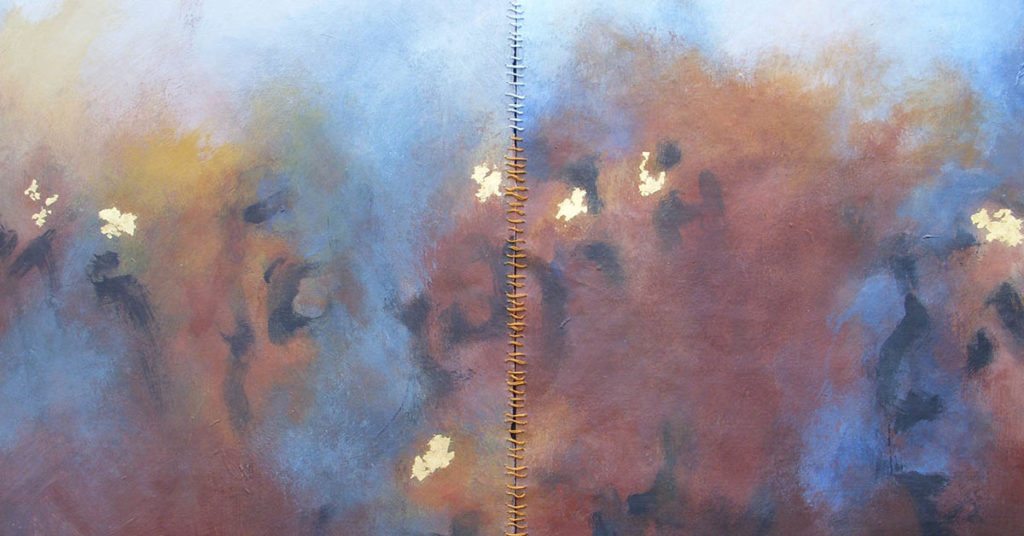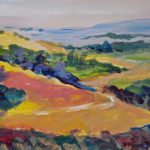The history of an individual’s life can be very interesting. Everyone has their own specific story to tell about how they have arrived in their own place in existence. This month’s artist, Isle of Pines resident, Phyllis Thomas, has quite an interesting path that translates in a very special way through her paintings.
As a child and student, Phyllis created different opportunities to keep art in her life. “All through grade school, I was the class artist and through high school, so I always knew I wanted to be an artist or do something with art. I wanted to go to art school. My father was wise and said ‘you need to make sure you can make a living,’ so I got my degree in Art Education and was an art educator,” said Phyllis.
Although Phyllis found a way to stay involved in her passion by becoming an art teacher, later that was challenged by a life changing opportunity. She and her husband made the decision to become missionaries, which meant they would live in Kenya. They were missionaries for 18 years, only returning home every three to four years for a couple of months. Her time in Africa significantly changed Phyllis’ outlook on life and how she and her family went about everyday life.
“When we initially went, of course everything was exciting, it was wonderful; the culture, the country itself, and the people. We did have to look at the culture and see how we could fit in. Kenyans are not clock oriented or time oriented. If you are with someone, you are with them and it doesn’t matter what the clock says. They’re just very personable. That was a good way to slow us down and to just really enjoy people. Building relationships was really, really important and it was a big thing for us that changed compared to the American lifestyle, which is so busy and clock oriented, so it was a good place for us to just kind of learn to live and love people,” said Phyllis.
With the responsibilities of being a teacher, missionary, and mother, her art came more in the form of encouraging her children and others around her to be creative. But individually as a painter and artist, Phyllis did not work on her own art pieces for nearly 20 years. As a missionary in Kenya, Phyllis met another artist by the name of Debbie Edwards and the two started painting together.
The culture and lifestyle Phyllis adopted as a missionary in Kenya translates through in her artwork. “I like to think of my art as a place to slow down. Most of my art has space for your eye to rest. It’s not just full of images and lines and marks and shapes, but there’s usually a place that you can slow down and look. What I desire for other people is to take that time, because I think it’s one way to help people stop in their busy life. I hope that’s one of the things it will do. It’s based much on my own personal life and what I see around me. Much of it is based on scripture. It’s what I call my visual translation. I look at art as being a language, so I’m translating words or emotions or thoughts or things I see into a visual language with the vision on the canvas,” said Phyllis.
To go along with her unique life’s journey, Phyllis has a distinctive approach to going about her paintings. She will spend an extraordinary amount of time reading and researching about the topic in which inspired her on a particular project. Being a former missionary and a full time staff member at Cru (Campus Crusade for Christ), much of Phyllis’ work is inspired by spirituality.
“It’s not just putting paint on the canvas. I do a lot of reading, read historical information, I look up meanings of words. I’ll read other articles, other authors. I’m reading all the time. All of that sort of goes into what the piece is going to be. When I’m done, I write about it too. I write a reflection, and that to me completes the whole piece, because then I’m sharing what I’ve learned as I made the piece as well,” said Phyllis.
“Unearthed Evidence” is a series of art work Phyllis created in which she derived inspiration from the discovery of the Dead Sea Scrolls. Over many years Phyllis saved literature on the Dead Sea Scrolls out of pure interest. After spending lots of time reading and researching, she felt compelled to complete works of art to encapsulate her thoughts, feelings, and emotions regarding everything associated with the famous archeological discovery.
Although Phyllis loves art and painting, she takes her role and identity as an artist very seriously. She has a tremendous amount of gratitude for her abilities as an artist and feels she has learned how to speak to people in a very deep way by the gifts she has been given.
“I have learned that being an artist is a very special gift, and I believe it is a gift given by God to me. I learned that it’s important to take that gift seriously – not just think of it as a hobby or something that you will do when you have time, but to really be intentional about learning to be the best you can. Be excellent, and make work that is honoring to God and beautiful, bringing beauty into the world. All of these things I have learned. It opens part of my heart and soul when I’m doing the work, and I believe that’s because that’s my calling and it’s what I’m supposed to do,” said Phyllis.
For more information about Phyllis Thomas and her work please visit phyllisthomasart.com. Additionally, her art is displayed at a gallery at the Lake Hart Headquarters of Cru.



